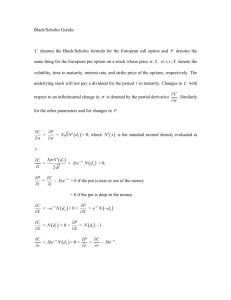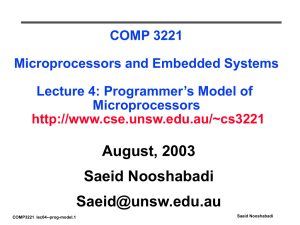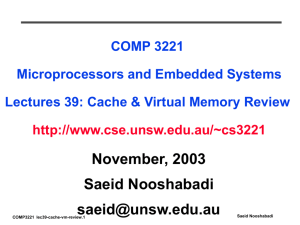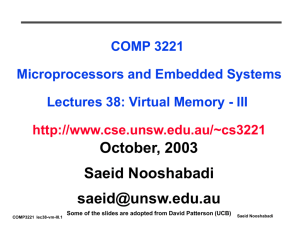Document
advertisement
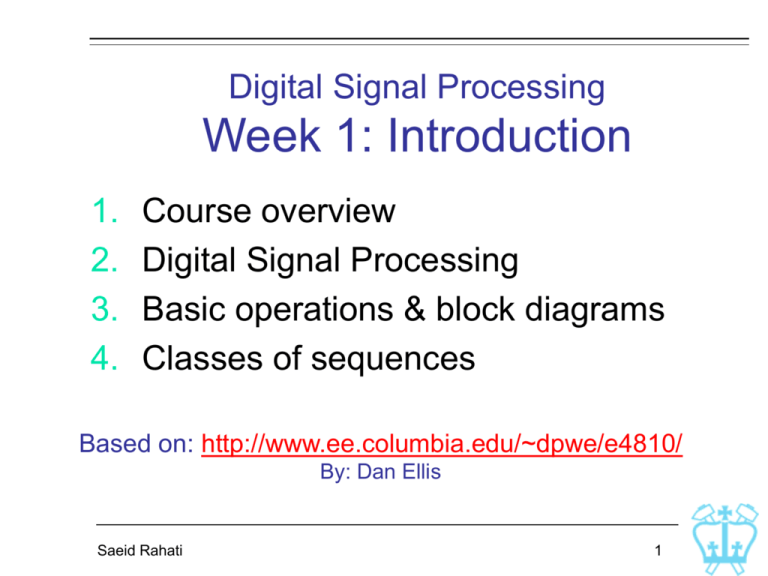
Digital Signal Processing
Week 1: Introduction
1.
2.
3.
4.
Course overview
Digital Signal Processing
Basic operations & block diagrams
Classes of sequences
Based on: http://www.ee.columbia.edu/~dpwe/e4810/
By: Dan Ellis
Saeid Rahati
1
1. Course overview
Grading structure
Homeworks (and small project): 10%
Midterm: 20%
Presentation (Max. 20 minutes): 10%
One paper related to course topics
Final exam: 30%
One session
One session
Project: 30%
Saeid Rahati
2
1. Course overview
Course project
Goal: hands-on experience with DSP
Practical implementation
Work in pairs or alone
Brief report, optional presentation
Recommend MATLAB
Ideas on DSP_Pack CD or past class or
internet
Saeid Rahati
3
MATLAB
Interactive system for numerical
computation
Extensive signal processing library
Focus on algorithm, not implementation
Saeid Rahati
4
2. Digital Signal Processing
Signals:
Information-bearing function
E.g. sound: air pressure variation at a
point as a function of time p(t)
Dimensionality:
Sound: 1-Dimension
Grayscale image i(x,y) : 2-D
Video: 3 x 3-D: {r(x,y,t) g(x,y,t) b(x,y,t)}
Saeid Rahati
5
Example signals
Noise - all domains
Spread-spectrum phone - radio
ECG - biological
Music
Image/video - compression
….
Saeid Rahati
6
Signal processing
Modify a signal to extract/enhance/
rearrange the information
Origin in analog electronics e.g. radar
Examples…
Noise reduction
Data compression
Representation for
recognition/classification…
Saeid Rahati
7
Digital Signal Processing
DSP = signal
processing on a
computer
Two effects:
discrete-time,
discrete level
Saeid Rahati
8
DSP vs. analog SP
Conventional signal processing:
p(t)
p(t)
Processor
q(t)
Digital SP system:
A/D
Saeid Rahati
p[n]
Processor
q[n]
D/A
q(t)
9
Digital vs. analog
Pros
Noise performance - quantized signal
Use a general computer - flexibility,
upgrade
Stability/duplicability
Novelty
Cons
Limitations of A/D & D/A
Baseline complexity / power consumption
Saeid Rahati
10
DSP example
Speech time-scale modification:
extend duration without altering pitch
M
Saeid Rahati
11
3. Operations on signals
Discrete time signal often obtained by
sampling a continuous-time signal
Sequence {x[n]} = xa(nT), n=…-1,0,1,2…
T= sampling period; 1/T= sampling frequency
Saeid Rahati
12
Sequences
Can write a sequence by listing values:
{x[n]} {, 0.2, 2.2,1.1, 0.2, 3.7, 2.9,}
Arrow indicates where n=0
Thus, x[ 1] 0.2, x[0] 2.2, x[1] 1.1,
Saeid Rahati
13
Left- and right-sided
x[n] may be defined only for certain n:
N1 ≤ n ≤ N2: Finite length (length = …)
N1 ≤ n: Right-sided (Causal if N1 ≥ 0)
n ≤ N2: Left-sided (Anticausal)
Can always extend with zero-padding
Left-sided
Saeid Rahati
Right-sided
14
3. Basic Operations on sequences
Addition operation:
x[n]
Adder
y[n]
y[n] x[n] w[n]
w[n]
Multiplication operation
A
Multiplier x[n]
Saeid Rahati
y[n]
y[n] A x[n]
15
More operations
Product (modulation) operation:
y[n]
x[n]
Modulator
w[n]
y[n] x[n] w[n]
E.g. Windowing: multiplying an infinitelength sequence by a finite-length
window sequence to extract a region
Saeid Rahati
16
Time shifting
Time-shifting operation: y[n] x[n N ]
where N is an integer
If N > 0, it is delaying operation
Unit delay x[n]
z
1
y[n]
y[n] x[n 1]
If N < 0, it is an advance operation
Unit advance
x[n]
Saeid Rahati
z
y[n]
y[n] x[n 1]
17
Combination of basic operations
Example
1 x[n]
2 x[n 1]
y[n]
3 x[n 2] 4 x[n 3]
Saeid Rahati
18
Up- and down-sampling
Certain operations change the effective
sampling rate of sequences by adding
or removing samples
Up-sampling = adding more samples
= interpolation
Down-sampling = discarding samples
= decimation
Saeid Rahati
19
Down-sampling
In down-sampling by an integer factor
M > 1, every M-th samples of the input
sequence are kept and M - 1 in-between
samples are removed:
xd [n] x[nM ]
x[n]
M
xd [n]
Saeid Rahati
20
Down-sampling
An example of down-sampling
Input Sequence
1
0.5
Amplitude
Amplitude
0.5
0
-0.5
-1
Output sequence down-sampled by 3
1
0
-0.5
0
10
20
30
Time index n
x[n]
Saeid Rahati
40
-1
50
3
0
10
20
30
Time index n
40
y[n] x[3n]
21
50
Up-sampling
Up-sampling is the converse of downsampling: L-1 zero values are inserted
between each pair of original values.
x[n / L], n 0, L, 2 L,
xu [n]
otherwise
0,
x[n]
Saeid Rahati
L
xu [n]
22
Up-sampling
An example of up-sampling
Input Sequence
1
0.5
Amplitude
Amplitude
0.5
0
0
-0.5
-0.5
-1
Output sequence up-sampled by 3
1
0
10
20
30
Time index n
x[n]
40
-1
50
0
10
20
30
Time index n
40
50
xu [n]
3
not inverse of downsampling!
Saeid Rahati
23
Complex numbers
.. a mathematical convenience that lead
to simple expressions
A second “imaginary” dimension (j√-1)
is added to all values.
Rectangular form: x = xre + j·xim
where magnitude |x| = √(xre2 + xim2)
and phase q = tan-1(xim/xre)
Polar form: x = |x| ejq = |x|cosq + j· |x|sinq
jq
( e cos q j sin q )
Saeid Rahati
24
Complex math
When adding, real
and imaginary parts
add: (a+jb) + (c+jd)
= (a+c) + j(b+d)
When multiplying,
magnitudes multiply
and phases add:
rejq·sejf = rsej(q+f)
Phases modulo 2
Saeid Rahati
25
Complex conjugate
Flips imaginary part / negates phase:
conjugate x* = xre – j·xim = |x| ej(–q)
Useful in resolving to real quantities:
x + x* = xre + j·xim + xre – j·xim = 2xre
x·x* = |x| ej(q) |x| ej(–q) = |x|2
Saeid Rahati
26
4. Classes of sequences
Useful to define broad categories…
Finite/infinite (extent in n)
Real/complex:
x[n] = xre[n] + j·xim[n]
Saeid Rahati
27
Classification by symmetry
Conjugate symmetric sequence:
xcs[n] = xcs*[-n] = xre[-n] – j·xim[-n]
Conjugate antisymmetric:
xca[n] = –xca*[-n] = –xre[-n] + j·xim[-n]
Saeid Rahati
28
Conjugate symmetric decomposition
Any sequence can be expressed as
conjugate symmetric (CS) /
antisymmetric (CA) parts:
x[n] = xcs[n] + xca[n]
where:
xcs[n] = 1/2(x[n] + x*[-n]) = xcs *[-n]
xca[n] = 1/2(x[n] – x*[-n]) = -xca *[-n]
When signals are real,
CS Even (xre[n] = xre[-n]), CA Odd
Saeid Rahati
29
Basic sequences
1, n 0
d [ n]
0, n 0
Unit sample sequence:
Shift in time:
d[n - k]
Can express any sequence with d:
{0,1,2..}0d[n] + 1d[n-1] + 2d[n-2]..
Saeid Rahati
30
More basic sequences
Unit step sequence:
Relate to unit sample:
d[n] [n] [n 1]
1, n 0
[ n]
0, n 0
[n] k d[k]
n
Saeid Rahati
31
Exponential sequences
Exponential sequences= eigenfunctions
General form: x[n] = A·n
If A and
are real:
= 0.9
= 1.2
20
50
15
Amplitude
Amplitude
40
30
20
5
10
0
10
0
5
10
15
20
Time index n
|| > 1
Saeid Rahati
25
30
0
0
5
10
15
20
Time index n
25
|| < 1
32
30
Complex exponentials
x[n] = A·n
Constants A, can
be complex :
A = |A|ejf ; = e(s + jw)
x[n] = |A| esn ej(wn +
f)
scale varying
magnitud
e
Saeid Rahati
varying
phase
33
Complex exponentials
Complex exponential sequence can
‘project down’ onto real & imaginary
axes to give sinusoidal sequences
q
1
e
x[n] exp( 12 j 6 )n Imaginary part cos q j sin q
j
Real part
1
xre[n]
0.5
Amplitude
0.5
Amplitude
1
0
-0.5
-1
xim[n]
0
-0.5
0
10
20
Time index n
30
40
-1
0
10
20
Time
index n
n/12
xre[n] = en/12cos(n/6) xim[n] = e
Saeid Rahati
30
sin(n/6)M
34
40
Periodic sequences
x [n] satisfying ~
A sequence ~
x [ n] ~
x [n kN ],
is called a periodic sequence with a
period N where N is a positive integer and
k is any integer.
x [ n] ~
x [n kN ]
Smallest value of N satisfying ~
is called the fundamental period
Saeid Rahati
35
Periodic exponentials
Sinusoidal sequence A cos(wo n f ) and
complex exponential sequence B exp( jwo n)
are periodic sequences of period N only if
w o N 2 r with N & r positive integers
Smallest value of N satisfying wo N 2 r
is the fundamental period of the
sequence
r = 1 one sinusoid cycle per N samples
r > 1 r cycles per N samples
M
Saeid Rahati
36
Symmetry of periodic sequences
An N-point finite-length sequence xf[n]
defines a periodic sequence:
“n modulo N”
x[n] = xf[<n>N]
Symmetry of xf [n] is not defined
because xf [n] is undefined for n < 0
Define Periodic Conjugate Symmetric:
xpcs [n] = 1/2(x[n] + x*[<-n >N])
= 1/2(x[n] + x*[N – n]) 0 ≤ n < N
Saeid Rahati
37
Sampling sinusoids
Sampling a sinusoid is ambiguous:
x1 [n] = sin(w0n)
x2 [n] = sin((w0+2)n) = sin(w0n) = x1 [n]
Saeid Rahati
38
Aliasing
E.g. for cos(wn), w = 2r ± w0
all r appear the same after sampling
We say that a larger w appears
aliased to a lower frequency
Principal value for discrete-time
frequency: 0 ≤ w0 ≤
i.e. less than one-half cycle per sample
Saeid Rahati
39
